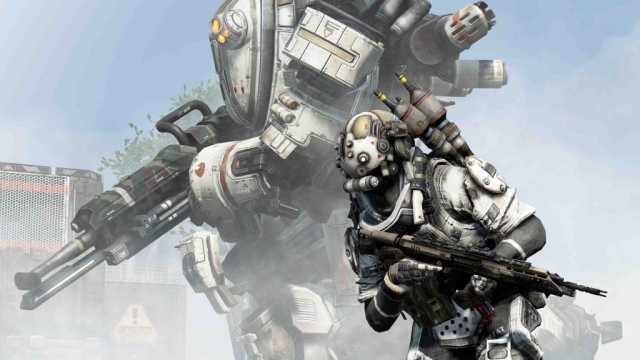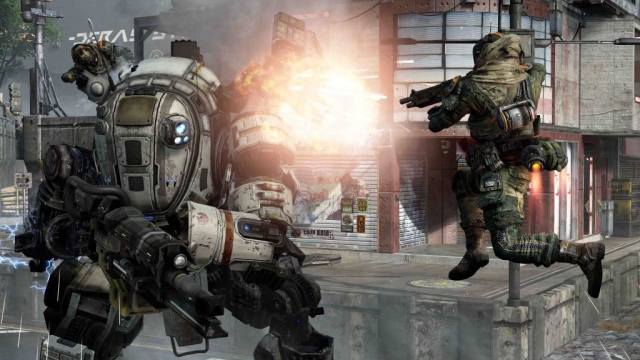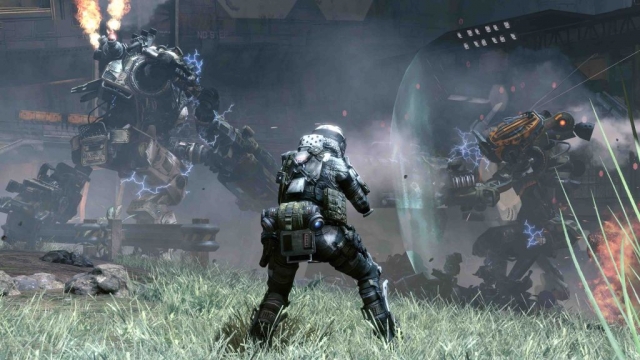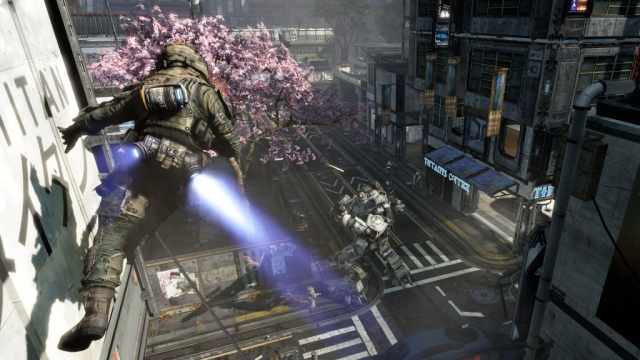Titanfall
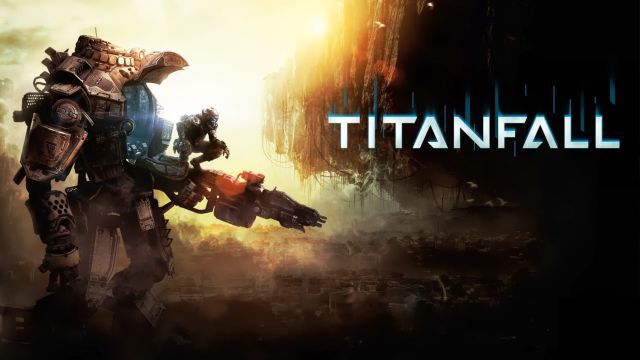
Ever since the Xbox One launched late last year, early adopters of the next-gen console have been waiting patiently for that one piece of software that would showcase the system and justify their $500 purchase. Has that game finally arrived? Stand by for Titanfall!
Anyone who’s read anything on Titanfall knows that it’s an online-only multiplayer first-person shooter. Respawn Entertainment chose to forgo the traditional single-player campaign in favor of a campaign multiplayer mode. Consisting of nine competitive matches, the multiplayer campaign details the conflict between the IMC, a corporate conglomerate specializing in resource extraction, and the Militia, a civilian resistance opposed to the IMC’s use of colony resources. Very little about the multiplayer campaign was revealed prior to the release of Titanfall, which immediately set off alarm bells, and surely enough, now that I’ve experienced the “story” from both sides of the war, my suspicion was correct – the multiplayer campaign is completely forgettable.
Conceptually, it’s just not a very good idea. Exposition, dialogue and the occasional brief cut-scene are presented prior to and during each match, providing background and stimulus for the conflict, but it’s hard to pay attention to and follow along with the story when other players are talking in the lobby, or when you’re customizing your loadouts and selecting your burn cards before the match, or while you’re, I don’t know, engaging in intense multiplayer firefights!? If you asked me to recount the events that took place during the campaign, I couldn’t. There were a few central characters to the story, but I couldn’t even tell you one of their names. It doesn’t even matter if you win or lose the match, on either side of the battle, the campaign progresses nonetheless with absolutely no changes to the plot. I don’t know if it was Respawn’s idea or if Electronic Arts said “Hey, we can’t release Titanfall without a campaign,” but the campaign multiplayer mode feels like it was thrown together last-minute. Luckily it only takes an hour or two to complete each side of the campaign, as you’ll be forced to do so in order to unlock the customizable Stryder and Ogre titan types.
Okay, so campaign multiplayer is a disappointment. The good news is it’s one of the few misses in Titanfall because the classic multiplayer modes are a total blast. To describe Titanfall as Call of Duty meets MechWarrior would be a disservice – it’s so much more than that. For starters, it’s incredibly smooth and fast-paced. As a pilot, you have two key abilities: double jump and wall run. Chaining these moves together will allow you to traverse the environment and gain verticality in a matter of seconds. The speed and free-flowing nature of movement is very reminiscent of Mirror’s Edge and is absolutely exhilarating to experience. These skills are also imperative to survival once titans enter the picture. These large, hulking machines change the dynamics of battle entirely when they’re called into action, forcing pilots to seek shelter or higher ground, or risk getting crushed under the titan’s sheer weight or by their firepower. Titans are by no means indestructible, however. Although titans do possess a recharging shield ala Master Chief in Halo, a single titan caught amongst a group of enemies can be taken down very quickly.
It’s here where Titanfall equally excels: game balance. An encounter between pilot and machine is not as one-sided as you might think. Not only are pilots equipped with anti-titan weaponry, if they can maneuver their way on top of a titan they can damage its core at a rapid rate. Even when two titans clash, there’s a surprising depth of strategy and tactics involved. While an Ogre titan (tank type) is well equipped to stand toe-to-toe with another titan, a Stryder titan (scout type) is more likely to dash around the battlefield and use the environment to their advantage. Each battle – pilot vs. pilot, titan vs. titan, pilot vs. titan, pilot and titan vs. pilot, pilot and titan vs. titan, or even pilot and titan vs. pilot and titan (you don’t necessarily have to be in your titan, you can have it follow you or guard an area) – is so very unique.
I know what you’re thinking, this sounds pretty daunting for people who don’t play first-person shooters religiously, but that’s another area where Titanfall excels. It is highly accessible to all players. Multiplayer matches are only 6v6, which I know a lot of people were worried about before they got their hands on the open beta a few weeks ago, but it’s a number that works perfectly within the design of the game. In addition to the six human players on either side, the battlefield is populated with numerous AI soldiers – grunts and specters that are easy prey for all manner of players (watch out, though, while the AI isn’t good enough to kill a pilot one-on-one, they have been known to take down a player if they find themselves in a pickle). Killing AI soldiers is an easy way not just to earn experience points, but also learn the effectiveness of each of the weapons, perfect the use of the pilot and titan abilities, and just as a way for players to contribute to the team’s success. Titanfall, in general, is very liberal with experience points, awarding them for simply calling in your titan (these work on a timer that counts down but can be sped up by killing members of the opposing team; human or AI), or simply participating in a match. It won’t be long before even the least-experienced player will rise amongst the ranks and become more powerful by unlocking new weapons and abilities.
Speaking of which, like every other modern shooter, Titanfall will have you earning experience points, gaining levels, and unlocking customization options. In addition to pre-set pilot and titan types, you’ll unlock customizable pilots and titans, as well as primary weapons, tactical abilities, ordnances, and perk kits for both pilots and titans, in addition to anti-titan weapons and sidearms just for pilots. Titanfall also introduces Burn Cards, earned by reaching level milestones and completing a plethora of challenges. Burn Cards are one-time use power-ups that you can activate before spawning, granting you a variety of bonuses such as a more lethal version of a weapon, an unlimited amount of ordnance, increased tactical abilities, and special abilities for your titan, just to name a few (Burn Cards only last until you die, at which point you can choose a new one). Some of the cards are common and some are rare, including the ability to call in a titan as soon as a match begins, swapping out your camo for that of a spectre, revealing the location of all members of the opposing team, or shaving time of your titan counter. You can take up to three Burn Cards into any match, adding yet another twist to an already multi-dimensional multiplayer experience.
The best part of Titanfall is how much fun it is, addictively so. Every match is a highlight reel of awesome moments. Like the time I stopped mid-wall run to pick off an enemy pilot that was chasing me; or the time I played a Burn Card that granted me unlimited satchel charges, so I threw about ten of them on the ground and baited a titan towards me, set off the explosives and lay waste to the mammoth machine; or the time I tricked an enemy pilot who was rodeo’ing my titan into thinking I was dismounting my machine to escape certain death, only all I did was duck down and when he jumped off my titan I punched him into oblivion; or the time I destroyed four titans at once – after they thought they had cornered me – with a nuclear explosion Burn Card that I was able to witness from 100-feet up upon ejection. I’ve said “Xbox, Record That” more times playing Titanfall than all of my other Xbox One games combined, and it’s these amazing moments that help define Titanfall.
Besides campaign multiplayer mode, Titanfall does exhibit a few other shortcomings. For instance, while I credit Respawn for including 15 multiplayer maps, there are only a handful of game modes available, and considering two of them – Attrition and Pilot Hunter – are basically Team Deathmatch with different scoring systems, that means there’s really only four modes. It’s unfortunate that the creativity that found it’s way into the gameplay didn’t translate into some new and exciting game modes, as what’s present is pretty standard fare. It also would have been nice to be able to customize the look of your titan to make it stand out on the battlefield, and more than three pilot and titan types would have added some much needed variety as well. For a universe where humans can pilot mechs and ships can jump into hyperspace, the selection of primary weapons for pilots – with the exception of the smart pistol – seems a little generic. Are we really still using assault rifles and sniper rifles this far into the future? Speaking of sniper rifles, with an emphasis on pilot mobility I see no reason for them to exist in Titanfall. Also, why is there no clan support? You’ve made room for Regen markers, why not let players design clan flags to showcase their squads? Okay, I’m starting to nit-pick a little, especially since some of these issues can and may be resolved in updates, premium DLC, or the inevitable sequel.
Titanfall is a good-looking game, due in large part to its art design. The environments are well varied and the titan designs are really quite spectacular. There are also some interesting creature designs that unfortunately don’t play a large role in the game, but show promise for the future of the franchise and what we might see down the road. What takes the cake visually, though, is the animation. Pilots move with such fluidity and watching a titan reach into the belly of another titan and rip it’s pilot out and throw him to the ground (or rip a titan’s arms off before it slouches to the ground and explodes) is something that never gets old. In the dozens of hours that I’ve put into Titanfall, the framerate has been pretty solid for the most part. When the battlefield is full of titans engaged in combat, specifically melee, the game can stutter a bit, but I was very happy with the performance overall.
The sound design is equally impressive. The voice acting during the multiplayer campaign isn’t all that great, but then again the material they have to work with is pretty weak. What is great is the feedback you constantly receive on the battlefield. Little audio cues that let you know when you’re winning or losing a match, when an enemy titan is about to drop out of the sky, when you’re being surrounded by enemy titans, or when your titan takes critical damage are fantastic. It’s one less thing to look for or worry about when you’re being fed audio cues like that. The titans themselves sound imposing as they stomp around the battlefield, the weapon effects are spot on, and the soundtrack – while maybe not quite as important as in a single-player game – is still very effective here as well.
Titanfall is a great start to an exciting new franchise. Sure, campaign multiplayer is a disappointment and I wish there was a little more meat on the bones in terms of game modes and pilot and titan types, among other things – but the gameplay is outstanding. It’s fast-paced, super smooth, highly accessible, very well balanced, steeped in strategy and tactics, constant and satisfying in its rewards, ridiculous amounts of fun, and every match is a highlight reel of awesome. It doesn’t reinvent competitive multiplayer shooters, but it does reinvigorate a genre that quite frankly has become stagnant, uninspired and elitist in recent years. So yes, your wait is over Xbox One owners, Titanfall is that game.
Reviewed By: Stephen Riach
Publisher: Electronic Arts
Rating: 88%
——————————————————————————–
This review is based on a retail copy of Titanfall for the Xbox One provided by Electronic Arts.
 Game Over Online
Game Over Online